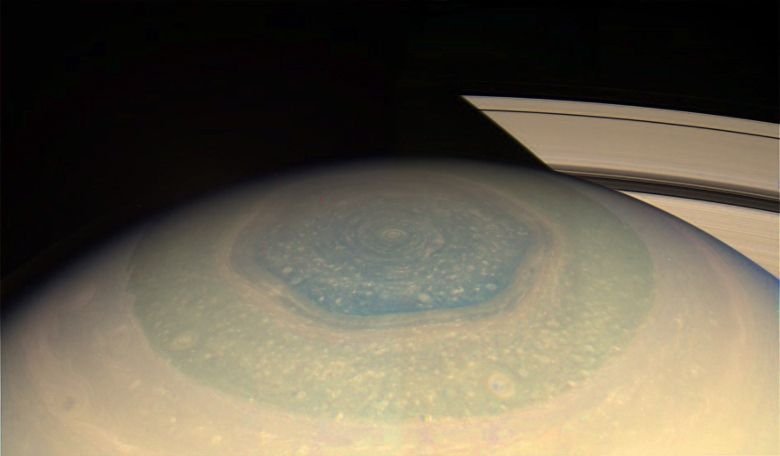15 September, 2018 marked the first anniversary since the Cassini spacecraft plunged into the crushing atmospheric depths of the gas giant it was primarily sent to study, Saturn, and the legacy of this ground-breaking mission is still revealing wonders of this ringed planet, as scientists discover a high-altitude vortex that could be a towering structure spanning hundreds of kilometres in height.
Discovered by an international team of scientists as part of a long term study, their analysis reveals the first glimpses of another stunning atmospheric vortex at the planet’s north pole; a region that is now warming up as it nears the Saturnian summertime.
And, like Saturn's other famous atmospheric phenomena that dominates the body of this enigmatic gas giant, this too is hexagonal-shaped.
It is perhaps no coincidence that these two huge structures are located in the same region and indeed it could be indicative that the lower-altitude hexagon is influencing what happens up above.
“The edges of this newly-found vortex appear to be hexagonal, precisely matching a famous and bizarre hexagonal cloud pattern we see deeper down in Saturn’s atmosphere,” says Leigh Fletcher of the University of Leicester, UK, lead author of the new study and contributor to ROOM - The Space Journal.
“While we did expect to see a vortex of some kind at Saturn’s north pole as it grew warmer, its shape is really surprising. Either a hexagon has spawned spontaneously and identically at two different altitudes, one lower in the clouds and one high in the stratosphere, or the hexagon is in fact a towering structure spanning a vertical range of several hundred kilometres.”
Saturn's original visually striking hexagon was discovered by NASA's Voyager spacecraft in the 1980s. Its sides stretch for a staggering 14,500 kilometres (9,000 miles) – that’s over two thousand kilometres more than the diameter of Earth – and its origin is thought to be tied to Saturn’s rotation in much the same way as the Polar Jet Stream is on our planet.
This new structure on the other hand has remained hidden from sight until now, as cooler temperatures at the start of Cassini’s mission meant its Composite Infrared Spectrometer (CIRS) could not peek further up in the northern stratosphere as the region was around 20 degrees too cold for reliable CIRS observations.
Despite being higher in the cloud-tops, this new structure has only come to light now as cooler temperatures at the start of Cassini’s mission, meant its Composite Infrared Spectrometer (CIRS) could not provide reliable CIRS observations. As the northern stratosphere has began to warm up in the last few years however, the polar vortex has became more and more visible.
“One Saturnian year spans roughly 30 Earth years, so the winters are long,” adds co-author Sandrine Guerlet from Laboratoire de Météorologie Dynamique, France. “Saturn only began to emerge from the depths of northern winter in 2009, and gradually warmed up as the northern hemisphere approached summertime.”
Whether or not the two hexagons are indeed linked as a huge towering structure remains unclear, although Fletcher and colleagues are skeptical this is the case given that wind conditions change considerably with altitude and that waves like the hexagon should be unable to propagate upwards.
“We simply need to know more. It’s quite frustrating that we only discovered this stratospheric hexagon right at the end of Cassini’s lifespan,” added Fletcher.
These stunning northern hexagon vortexes are a sharp contrast to Saturn’s south pole, which although does have a vortex, is not nearly as impressive as its northern counterpart. This dichotomy of designs indicates that the ringed-planet’s two poles behave very differently and that there is much more to learn about the dynamics at play in the gas giant’s atmosphere.
“Saturn’s northern hexagon is an iconic feature on one of the most charismatic members of the Solar System, so to discover that it still holds major mysteries is very exciting,” says Nicolas Altobelli, ESA Project Scientist for the Cassini-Huygens mission.











